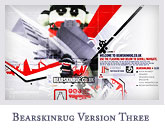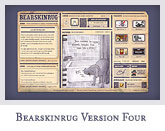The Professional Webspace of Designer and Illustrator Kevin Cornell:
"Design, Art, and Lackluster Humor."

The Skinny on Bearskinrug
Bearskinrug was created in February of 2000, as the personal site of Kevin Cornell. It currently exists in its fifth incarnation, and has drifted wide of Mr. Cornell's original intention — documenting the creation of his own deadly martial art. Instead, it delivers the excruciatingly banal prose of Kevin, houses his online portfolio as well as his shop, and displays the only existing picture of the author facing left.
Mr. Cornell is currently accepting requests for freelance work. Feel free to use the Submittal
Form to the right. While he doesn't require it, Kevin does enjoy inquiries in the form of a
limerick.
Of Interest on the Site
You are more than welcome to explore the variety of distractions on Bearskinrug. If, however, you wish to take the condensed tour, you might want to visit these popular spots:
Or, if you'd like a couple suggestions of Articles to start with, you might want to try:
Much Thanks
Deepest appreciation goes to Jason Santa Maria and Shaun Inman, without whose advice and programming help this site would surely have never seen the light of day. Thanks for all the help, gents!
Thanks also to Dan Mall, whose scary javascript and css voodoo magic made the category sorting in the Store possible, as well as the excellent flash viewer in the Signal Flares page.
Syndication and Twitter
The following xml feeds are available for those who are hungry:
If you'd like to follow my twitter, I'm at @bearskinrug. Which should be easy to remember, since that's the street I live on. I try and keep my twitter neat and clean. I just post to comics I make here and on other sites, and occasionally I'll post a one-liners like you see in the site footer below. Sometimes I retweet news relevant to me. I try to avoid @replies to help keep my stream tidy.
Whereskinrug?
Bearskinrug is proudly published from Philadelphia, Pennsylvania. Feel free to check out these other Philadelphia-based (or formerly Philadelphia-based) artists:
Are You British? [ a ]
No. I just happen to have bought a .co.uk address back when my only other options were .com, .net, and .org,
which had been all snatched up. So that makes me a Yank. Which unfortunately means I can't be knighted. And just as
unfortunately, America has no equivalent honor — except maybe appearing on the cover of Time magazine. But I suspect I may
only make it as far as Sun-Poisoning Quarterly.

Contact Form

Helpful Tips on Working With Illustrators
Why choose an Illustrator? [ a ]
One of the best uses of an illustration is as a visual "hook". Something to quickly catch the reader's eye, intrigue them, and lead them deeper into the content.
About an Illustrator's style [ a ]
Illustrators generally cultivate one or two styles, that become their signature — what makes them unique. What you're looking for in an illustrator is someone whose style is best suited to the message you're trying to get across.
While working outside of a style (or mimicking someone else's style) is not unheard of, when you hire an illustrator, be aware that their own personal style is inherent to their work.
About an Illustrator's medium [ a ]
Part of an illustrator's style is dictated by the medium they work in. There are many different niches that different illustrators occupy. While some excel at large format paintings for poster reproduction, others might be more adept at vector art, acrylic paintings, or graphite.
Try and familiarize yourself with different mediums, so you can clearly communicate with the illustrator the look and feel you're interested in.
Trade practices
Here's some common terms and concepts to familiarize yourself with, if you plan to work with with an Illustrator:
Copyright [ a ]
According to Copyright laws, an illustrator inherently owns the copyright to his or her work upon creation. This Copyright is actually a bundle of individual rights. If you plan to hire an illustrator, be aware there are certain rights that must be purchased in writing so they're legally transferred. Here's some terms frequently used in contracts to specify portions of the rights bundle:
One-Time Rights: Client purchases right to publish illustration on a one-time basis
First-Rights: Client purchases right to publish illustration first, usually on a one-time basis as well
Exclusive Rights: Client purchases exclusive right to publish within a particular market, for a contracted period of time.
All Rights: Client purchases the entire copyright from Illustrator. This transfer usually is for a specified time period, and can (and should) cost between 200-300% of the price of the job.
A credit line is usually required somewhere on the piece, acknowledging the Illustrator. This line is usually in a form generally known as the Notice of Copyright.
For further information on U.S Copyright Laws, International Copyright Laws, or the Copyright Bundle visit the U.S. Copyright Office Website.
Cancellation (Kill Fees) [ a ]
An illustrator is considered to be working the moment pen touches paper. If a job gets cancelled halfway through production, it's proper to pay the illustrator for the work they've accomplished thus far. This is generally referred to as a "Kill Fee", and commonly is paid in a percentage of either 50% if preproduction work has been done, or 100% if the finished illustration has been completed.
Rates and Costs [ a ]
Dependent on the medium, whether the art is black-and-white or color, and the placement of the job, an Illustrator may charge with flat rates, hourly fees, or a combination of both. As is common with many other contractors in the design industry, an illustrator should be paid 50% of their estimate before starting work. This creates an air of good-faith and shared responsibility between the two parties.
If you're unsure of current industry rates, consult the Graphic Artist's Guild Handbook: Pricing and Ethical Guidelines.
Rush Fees [ a ]
In instances of tight turnaround, it's not uncommon for a contractor to charge extra — this is known as a rush fee. Rush Fees can be up to 25 to 50% of the original estimate.
Generally a small job that requires turnaround in less than a week is eligible for a rush fee. What's considered a small job? Well, a finished color spot-illustration would fall in that area. Keep in mind that even simple stuff requires a rough concepting stage, and it would be more efficient to get approval on a roughed-up concept than a finished watercolor.
A big job, like say, 4 finished 8 x 10 color illustrations, depicting a complex scene, would be estimated as a month, maybe two-month job. For the most part, the turnaround that triggers a rush fee will vary according to project scope. But as far as most illustrators are concerned — if they have to work weekends, or nights to finish on time — it probably justifies a rush fee. But these things are always negotiable.

Search Bearskinrug:

Other Sections You Might Want To Visit:
- The Downloads Section: Wallpapers for the Discerning Desktop.
- The Links Archive: A Collection of Interesting Tidbits.


